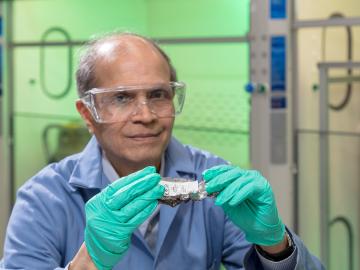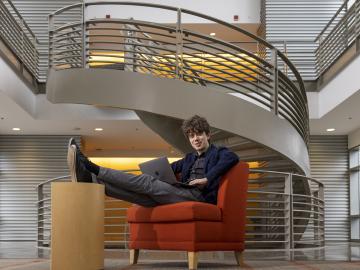
Filter News
Area of Research
- (-) Materials (126)
- (-) Supercomputing (111)
- Advanced Manufacturing (5)
- Biological Systems (1)
- Biology and Environment (73)
- Building Technologies (1)
- Clean Energy (132)
- Climate and Environmental Systems (2)
- Computational Engineering (1)
- Computer Science (4)
- Electricity and Smart Grid (1)
- Energy Sciences (2)
- Fuel Cycle Science and Technology (1)
- Fusion and Fission (24)
- Fusion Energy (8)
- Isotope Development and Production (1)
- Isotopes (19)
- Materials Characterization (2)
- Materials for Computing (5)
- Materials Under Extremes (1)
- National Security (38)
- Neutron Science (59)
- Nuclear Science and Technology (24)
- Nuclear Systems Modeling, Simulation and Validation (2)
- Quantum information Science (3)
News Topics
- 3-D Printing/Advanced Manufacturing (10)
- Advanced Reactors (2)
- Artificial Intelligence (19)
- Big Data (11)
- Bioenergy (8)
- Biology (5)
- Biomedical (11)
- Biotechnology (2)
- Buildings (3)
- Chemical Sciences (18)
- Climate Change (13)
- Composites (2)
- Computer Science (40)
- Coronavirus (10)
- Critical Materials (6)
- Cybersecurity (2)
- Decarbonization (7)
- Energy Storage (13)
- Environment (15)
- Exascale Computing (14)
- Frontier (16)
- Fusion (3)
- Grid (4)
- High-Performance Computing (20)
- Irradiation (1)
- Isotopes (4)
- Machine Learning (8)
- Materials (44)
- Materials Science (38)
- Mathematics (1)
- Microscopy (9)
- Molten Salt (2)
- Nanotechnology (17)
- National Security (4)
- Net Zero (2)
- Neutron Science (23)
- Nuclear Energy (9)
- Partnerships (6)
- Physics (18)
- Polymers (8)
- Quantum Computing (8)
- Quantum Science (15)
- Renewable Energy (1)
- Security (2)
- Simulation (9)
- Software (1)
- Summit (19)
- Sustainable Energy (9)
- Transformational Challenge Reactor (2)
- Transportation (7)
Media Contacts

Oak Ridge National Laboratory researchers have developed a thin film, highly conductive solid-state electrolyte made of a polymer and ceramic-based composite for lithium metal batteries.

For the second year in a row, a team from the Department of Energy’s Oak Ridge and Los Alamos national laboratories led a demonstration hosted by EPB, a community-based utility and telecommunications company serving Chattanooga, Tennessee.

With Tennessee schools online for the rest of the school year, researchers at ORNL are making remote learning more engaging by “Zooming” into virtual classrooms to tell students about their science and their work at a national laboratory.

OAK RIDGE, Tenn., May 5, 2020 — By 2050, the United States will likely be exposed to a larger number of extreme climate events, including more frequent heat waves, longer droughts and more intense floods, which can lead to greater risks for human health, ecosystem stability and regional economies.

In the early 2000s, high-performance computing experts repurposed GPUs — common video game console components used to speed up image rendering and other time-consuming tasks

In the Physics Division of the Department of Energy’s Oak Ridge National Laboratory, James (“Mitch”) Allmond conducts experiments and uses theoretical models to advance our understanding of the structure of atomic nuclei, which are made of various combinations of protons and neutrons (nucleons).

In the race to identify solutions to the COVID-19 pandemic, researchers at the Department of Energy’s Oak Ridge National Laboratory are joining the fight by applying expertise in computational science, advanced manufacturing, data science and neutron science.

Scientists at Oak Ridge National Laboratory used a focused beam of electrons to stitch platinum-silicon molecules into graphene, marking the first deliberate insertion of artificial molecules into a graphene host matrix.

Three technologies and one commercialization program developed at the Department of Energy’s Oak Ridge National Laboratory have won National Technology Transfer Awards from the Federal Laboratory Consortium.

Joe Paddison, a Eugene P. Wigner Fellow at the Department of Energy’s Oak Ridge National Laboratory, believes there’s more information to be found in neutron scattering data than scientists like himself might expect.


